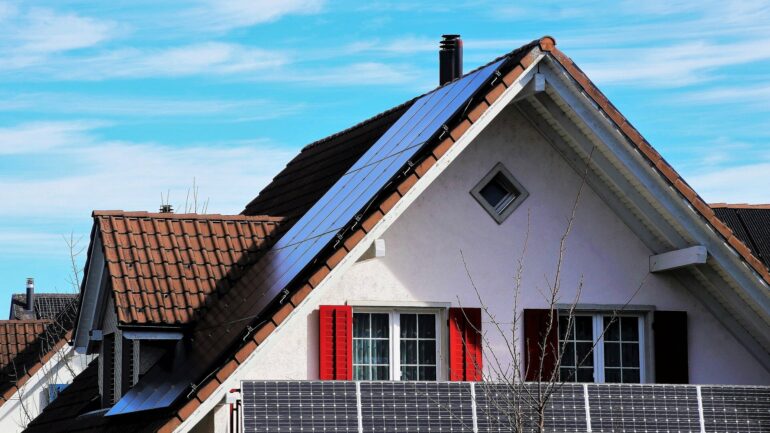Widespread coverage of building rooftops with conventional photovoltaic solar panels may increase temperatures on hot days and lower them at night, says new modeling.
The research led by Dr. Ansar Khan from the University of Calcutta and co-authored by UNSW Sydney Scientia Professor Mattheos (Mat) Santamouris used mesoscale (weather system) simulations due to the absence of available observational data for rooftop photovoltaic solar panels (RPVSPs) to model their impact on local climate conditions at the city scale.
They found that in a scenario with complete RPVSP coverage in a city, the urban temperature could increase in the day up to 1.5°C during peak summer periods and decrease at nighttime up to 0.6°C.
The findings, published in Nature Cities, don’t suggest that PVs aren’t an important renewable energy solution in the transition away from fossil fuels. Instead, the researchers say it highlights the opportunity to develop integrated solutions for RPVSPs, such as reflective materials for rooftops and greenery combinations, to balance their many benefits with their potential drawbacks in urban environments.
“Photovoltaic solar panels are a significant renewable energy technology, but they can change the local conditions of cities when installed on rooftops at scale,” says Prof. Santamouris, the Anita Lawrence Chair in High-Performance Architecture at UNSW Arts, Design & Architecture. “Understanding these changes is crucial for decision-makers considering city-wide RPVSP usage and the strategies needed to deploy them effectively.”
Daytime heating and nighttime cooling effects
For the study, the research team analyzed the impact of RPVSPs under different coverage scenarios in Kolkata, India. They also conducted city-specific RPVSP sensitivity studies for four other cities—Sydney, Austin, Athens, and Brussels—to compare their findings with those from Kolkata.
“We found there is a linear association between the temperature increase and the percentage of rooftops covered with PVs,” Prof. Santamouris says. “Under the maximum scenario of 100% coverage during the peak summer period, our data shows that RPVSPs lead to a significant temperature increase during the day.”
Prof. Santamouris says the heat effect of PVs at 100% rooftop coverage would curb much of the renewable energy benefit. Estimations show that in Sydney, almost 40% of the electricity PVs produce is used to compensate for the overheating impact in additional cooling load—mainly air conditioning.
“When RPVSPs are installed on roofs, they absorb a significant amount of solar energy, converting some of it into electricity and generating heat in the process,” Prof. Santamouris says. “This is primarily due to the lower albedo (reflectance) of the panels, but also the airflow over the top and underside of the PVs, which amplifies the heating effect.
“This means, during the peak summer period, the surface can be as hot as 70°C, making it impossible to have a cooling effect on the urban temperature.”
Conversely, the transfer of heat through radiation at nighttime leads to the surface temperature of the PVs being lower than the urban temperature at nighttime, thereby lowering the surrounding air temperature. This is a crucial benefit as the impact of climactic warming is expected to be felt most acutely during nights, which could warm by around 4°C over the next century on average, Prof. Santamouris says.
The study also found RPVSPs can have additional complex effects on other local conditions. In particular, they can reduce pollutant concentrations by increasing the planetary boundary layer—the lowest part of the atmosphere that is influenced by the Earth’s surface conditions—leading to higher wind speeds and pollutant dilution.
“RPVSPs also enhance the penetration of coastal sea breezes further inland in coastal cities, while also reducing the concentration of pollutants at the ground level,” Prof. Santamouris says. “This goes some way to compensate for the increased temperature effect during the day and is important for cities like Kolkata where the problem of pollutants is very pressing.”
The promise of integrated solutions
Prof. Santamouris says it is possible to make RPVSPs that mitigate against their daytime heating impacts while maintaining their benefits using advanced cooling strategies. Additionally, innovations in cutting-edge materials science combined with RPVSPs have significant potential for creating cool PV systems that operate at lower temperatures and reduce heat impacts.
In particular, Prof. Santamouris advocates for the use of hybrid PV systems that integrate panels with a water-based thermal collection system to absorb excess heat for hot water production.
“It is already possible to cool down the surface of photovoltaics by circulating water,” Prof. Santamouris says. “Designs that run water behind the panels absorb excess heat and improve PV efficiency by lowering operating temperatures, while the excess solar energy can be channeled to provide cost-effective hot water.”
Highly reflective cool roof materials that bounce heat rather than absorb heat could also be used to boost the energy production of nearby RPVSPs while mitigating local urban heating during the day. Adding other heat sinks such as rooftop greenery can also improve PV efficiency.
“Combining PVs with green roofs or cool roofs can increase the capacity of PVs by up to 6–7% and significantly reduce surface temperatures,” Prof. Santamouris says.
“If we wish to continue to implement PVs on rooftops, these integrated solutions are something we must seriously consider maximizing RPVSP efficiency and also address the challenges of urban heat.”
More information:
Ansar Khan et al, Rooftop photovoltaic solar panels warm up and cool down cities, Nature Cities (2024). DOI: 10.1038/s44284-024-00137-2
Provided by
University of New South Wales
Citation:
Rooftop solar panels impact temperatures during the day and night in cities, simulation study shows (2024, October 11)



